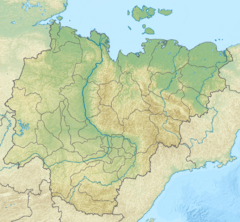Nuchcha
| Nuchcha Нучча / Нуучча | |
|---|---|
 Nuchcha course ONC map section | |
Mouth location in Yakutia, Russia | |
| Location | |
| Country | Russia |
| Physical characteristics | |
| Source | |
| • location | Kyun-Tas |
| • coordinates | 69°52′52″N 140°04′54″E / 69.88111°N 140.08167°E |
| • elevation | ca 900 metres (3,000 ft) |
| Mouth | Chondon |
• coordinates | 70°53′31″N 139°28′44″E / 70.89194°N 139.47889°E |
• elevation | 18 metres (59 ft) |
| Length | 243 km (151 mi) |
| Basin size | 2,410 km2 (930 sq mi) |
| Basin features | |
| Progression | Chondon → Laptev Sea |
The Nuchcha or Nuuchcha (Russian: Нучча; Yakut: Нуучча, romanized: Nûçça) is a river in the Sakha Republic (Yakutia), Russia. It is the longest tributary of the Chondon. The river has a length of 243 kilometres (151 mi) and a drainage basin area of 2,410 square kilometres (930 sq mi).[1]
The Nuchcha flows north of the Arctic Circle, across desolate territories of the Ust-Yansky District. An abandoned village named "Batagay" was located by the riverside in its lower course.[2][3] A 2021 Yakut fictional film which received an award at the Karlovy Vary International Film Festival was named Nuuchcha.[4]
Course
The Nuchcha is a right tributary of the Chondon. It has its sources in the northern slopes of the Kyun-Tas range. The river flows roughly northwards within a valley. After it leaves the mountainous terrain it heads across the Yana-Indigirka Lowland floodplain to the southwest of the Sellyakh. It flows slowly through flat terrain where it meanders very strongly among numerous lakes. Finally the river joins the Chondon 126 km (78 mi) from its mouth. Tumat, the nearest inhabited place, is located nearly 20 km (12 mi) upstream of the confluence.[2][3]
Tributaries
The main tributaries of the Nuchcha are the 45 km (28 mi) long Bylaat-Yurege (Былаат-Юрэгэ) and the 38 km (24 mi) long Buruuchaan-Yurege (Буруучаан-Юрюйэ) on the right, as well as the 26 km (16 mi) long Ekechan (Экэчан) on the left. The river is frozen between the beginning of October and the beginning of June. There are more than 1,300 lakes in its basin.[5]
See also
References
- ^ "Река Нуучча in the State Water Register of Russia". textual.ru (in Russian).
- ^ a b "R-53_54 Topographic Chart (in Russian)". Retrieved 24 May 2022.
- ^ a b Google Earth
- ^ Фильм "Нуучча" российского режиссера Мункуева получил Гран-при на кинофестивале в Чехии
- ^ Нучча - nature.ykt
External links
